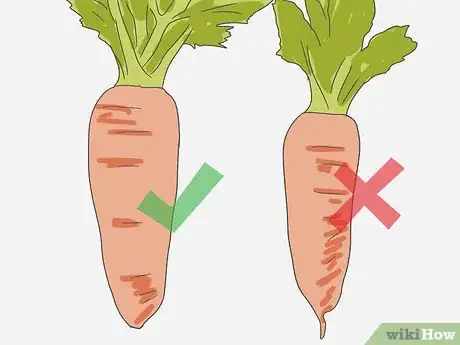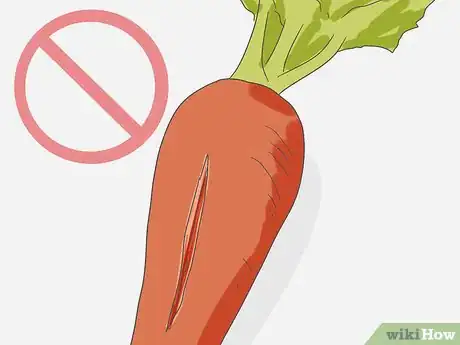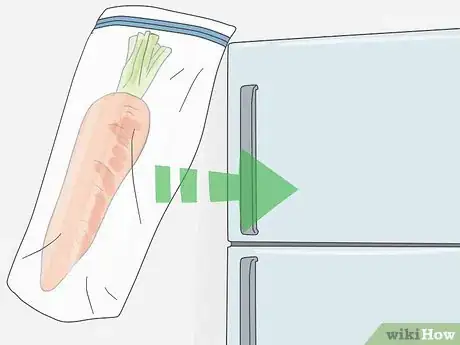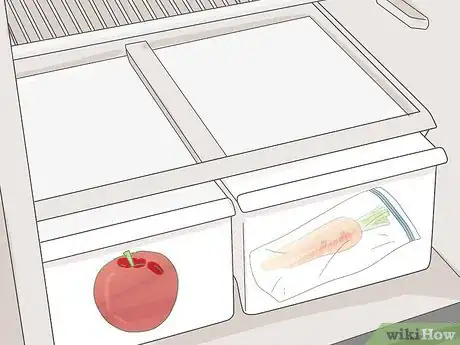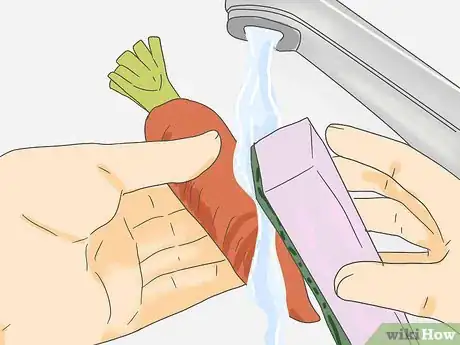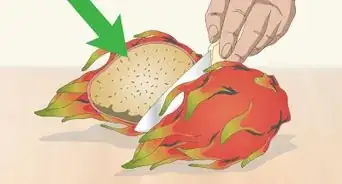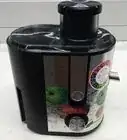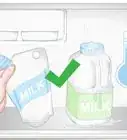This article was co-authored by wikiHow Staff. Our trained team of editors and researchers validate articles for accuracy and comprehensiveness. wikiHow's Content Management Team carefully monitors the work from our editorial staff to ensure that each article is backed by trusted research and meets our high quality standards.
This article has been viewed 121,064 times.
Learn more...
Carrots are versatile enough to be useful in both dinners and desserts. Getting quality carrots for these dishes depends on observation and proper storage. Quality carrots are brightly-colored. They have few cracks and feel crisp to the touch. When you get home, cut off any leaves and store the carrots in a plastic bag. Healthy carrots will then serve as a nutritious option for up to a few weeks.
Steps
Picking Healthy Carrots
-
1Pick out larger carrots for sweetness. Larger carrots tend to signify longer growing times. The longer the carrot is in the the ground, the more sugar it can develop. These carrots will have woodier cores you may wish to remove before eating.
- Fresher carrots are sweeter than older ones.
- Most baby carrots are regular carrots cut down to size and aren’t sweeter.
-
2Look for carrots with deep coloring. Fresher carrots have more intense pigmentation. You’ll be drawn to hearty orange coloring, but carrots come in plenty of other colors too. Purple, red, yellow, and white carrots may also be present. They’re as safe to eat as orange carrots and will also look more colorful when they’re at their freshest.[1]
- The coloring on a good carrot will be uniform from top to bottom.
Advertisement -
3Look for bright green leaves on carrot tops. You can also judge the carrot’s freshness by the color of the leaves. Fresher carrots have brighter leaves. Wilted leaves are a sign that they carrot has been sitting on the shelf for a while.[2]
- The leaves are more delicate than the rest of the carrot, so they’ll show age quicker. Selecting carrots with their tops still on is a great way to find the freshest carrots.
-
4Find carrots with a smooth shape. Most carrots are long and slender, although others are shorter and rounder. You’ll know when a carrot looks misshapen because it’ll look twisted or covered in small roots. The carrot will often look a little pale when this happens, so it’ll show its age.
-
5Avoid excessively cracked or split carrots. Cracks and splits are easy to detect before you even pick up the carrot. Lots of cracks or even a split shows that the carrot is drying out and losing flavor. Unless you want a carrot that tastes old and woody, skip it.[3]
- Many carrots develop some cracks from absorbing too much water while growing. These are still healthy to eat. Since everyone else may skip them, it can be better to choose them to avoid food waste.
- A few ridges or cracks are fine. As long as the carrot isn’t excessively or deeply cracked, chances are it’ll be okay for you to pick. Look around for soft spots and other problems to make sure.
-
6Choose carrots that feel firm to the touch. Pick up the carrot and run your fingers along it. It should feel plump and firm. The healthiest carrots are crisp. Soft spots are a sign of decay. Avoid carrots that feel limp or rubbery.[4]
- Carrots with a few soft spots haven’t gone bad yet. These carrots may still be eaten. Cut out the soft spots and use the carrots as soon as you can.
Storing and Using Carrots
-
1Cut off leafy tops. Carrots lose moisture through the leaves. This will cause them to dry out and begin to crack. As soon as you can, remove the tops. These leaves can be wrapped in a damp paper towel and used within a day or two as a slightly bitter seasoning.[5]
-
2Refrigerate the carrots in an unsealed plastic bag. The plastic bags you get from most stores when choosing produce work well for storage. Once any leaves are removed, you can place the carrots back inside the bag. The carrots give off moisture. In a sealed bag, the moisture collects and causes rot.[6]
- Keeping the carrots dry can help them last longer. Try lining the bag with paper towels. Change out damp towels once or twice a week.
-
3Store them in a cold area away from fruit. Pick the coldest area in your refrigerator. This is usually at the bottom or inside a crisper. The carrots must be kept away from food that produces ethylene gas, such as bananas or pears. The gas ages the carrots.
-
4Scrub the carrots before using them. Most carrots don’t need to be peeled. Removing the outer layer can cause you to lose some nutrients. Instead, rinse the carrots off in water. Rub off any dirt with your fingers, a brush, or a sponge.[7]
-
5Peel older carrots. Older carrots will have a more bitter skin than younger carrots. Peeling will usually make these carrots more enjoyable to eat. Younger carrots should also be peeled in recipes where tough, bitter skin may be overwhelming, such as when the recipe calls for steamed carrots.[8]
-
6Eat the carrots within a couple of weeks. With proper storage, carrots tend to last about two weeks. Those kept dried may last for over a month. Bitter flavors will develop as the carrots age. After about two weeks you may also notice soft spots or rot. It’s best to use the carrots as soon as possible to avoid this.[9]
- Carrots may also be blanched and frozen. These will last up to eight months, but the carrots lose some nutrients and flavor.
References
- ↑ http://www.fruitsandveggiesmorematters.org/carrots
- ↑ http://www.latimes.com/style/la-fo-carrots-seasonal-cooking-p-story.html
- ↑ http://www.organicauthority.com/vegetables/carrots.html
- ↑ http://www.today.com/food/fall-carrot-season-how-choose-store-cook-carrots-t45581
- ↑ http://www.today.com/food/fall-carrot-season-how-choose-store-cook-carrots-t45581
- ↑ http://www.organicauthority.com/vegetables/carrots.html
- ↑ http://www.bonappetit.com/test-kitchen/cooking-tips/article/why-you-shouldnt-peel-your-vegetables
- ↑ http://www.today.com/food/fall-carrot-season-how-choose-store-cook-carrots-t45581
- ↑ http://www.carrotmuseum.co.uk/carrotstorage.html
